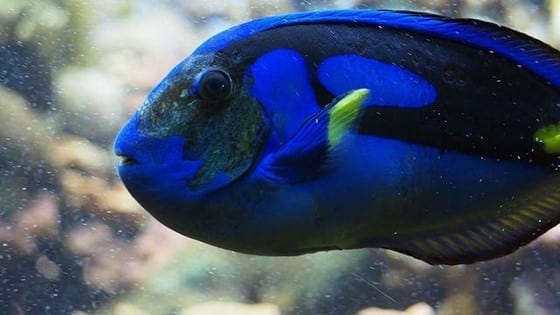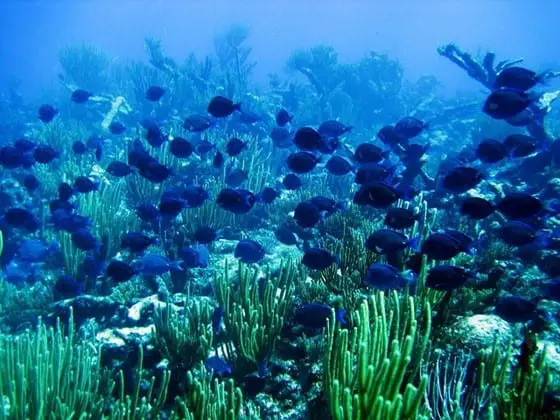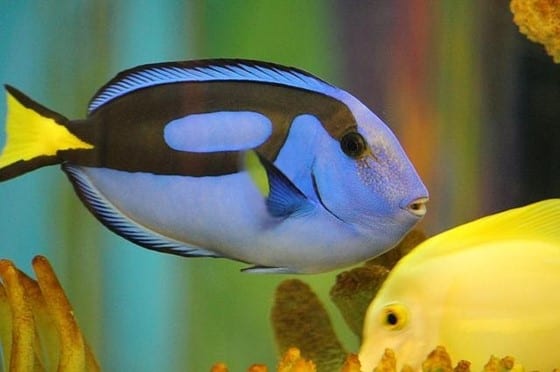Our seas and oceans are full of incredibly wonderful beings that give their waters light and color. This wide range of species makes it very difficult to choose one of them as the most fascinating. However, there is a unique fish that leaves no one indifferent. We are talking about the popular surgeonfish, whose name is not very accurate due to its colorful and beautiful appearance.
In the article that you will read below, you will have the opportunity to learn much more about blue tang fish: its behavior, characteristics, habitat, lifestyle, etc.
The basics
The blue tang fish is a very common aquarium fish. It became particularly popular after the movie “Finding Nemo” which was released in the year 2013 and 2016 follows “Finding Dory”. The colorful animal is native to Indo-Pacific, and are found in coral reefs of Australia, Philippines, Indonesia, East Africa and Sri Lanka.
Its scientific name is Paracanthurus hepatus. These beautiful blue objects are a fish of coral in the family Acanthuridae. It is the only member of the genus Paracanthurus.
For children, this fish may be just “Dory,” but it has other names as well. The scientific name of the animal is Paracanthurus hepatus. Other names by which it is known inlcude Royal Blue tang fish, Hippopotamus tang fish, Royal Blue tang fish, Palette Surgeonfish, , Flagtail tang fish, Blue Surgeonfish, as well as Pacific Blue tang fish.
They have spines that they usually hide but when they feel in danger, they take them out to defend themselves from their predators. This animal is round in shape and of a very striking and bright coloration. In general, their main color is dark blue while their fins have a yellow hue.
It is not a very large fish in size, about 30 centimeters in length. However, specimens have been found that have exceeded 70 centimeters in length. As for their weight, in nature they can reach 7-8 kilograms .Another of its notable characteristics is its longevity. It is a fish that under normal conditions can extend its life a few years, up to 15 specifically.
Behavior
As far as its character is concerned, when it is young it is a rather friendly and not very aggressive fish. It can coexist perfectly with other species in the same environment. Once he grows in age, his behavior is stronger and more defensive.
This fish is a very calm animal that stays hidden in the corals and plants of the reef to be safe. It only wanders away when looking for its food. They are solitary and territorial, so they can have problems with other specimens and different species.
Finally, it should also be mentioned that there are several kinds of blue tang fishes . The aforementioned characteristics and details may vary from one to another.

The surgeonfish stands out for its radiant color, oval body and flag-shaped tail. It has pectoral fins that are yellow in color. Adults usually have a narrow line of a dark hue along their dorsal fin that deviates backwards on the tail.
Their color tones will change as time passes and they mature. Young blue surgeonfish have a very bright yellow color. They have blue spots around their eyes, the fins are tipped with a very light blue tint that change to a blue hue as they get older.
Description
As mentioned above, paracanthurus hepatus has indigo blue, laterally compressed body and two black stripes. The upper one from the origin of the tail fin to the head, crossing the eye. The lower one, is approximately to the height of the pectoral fin, which are often joined leaving a blue circle in the middle. Its dorsal and anal fins are blue, both crowned by a black stripe. Its tail fin is yellow, as is the edge of its pectoral fins. The intensity of the coloring varies depending on age. In individuals that inhabit the Indian Ocean, the part near its tail is also yellowish. It measures up to 31 centimeters in length.

Diet and Reproduction
They are omnivorous animals, which means that their diet is usually very varied. They eat mostly algae and use their teeth to keep their coral protectors clean. They also feed on small insects, some larvae and even the eggs of other fish , zooplankton, scales, and lettuce. They also protect reef health by eating algae as it is known to cover corals.
These beautiful blue objects take a long time to reach sexual maturity, about two years. Like the majority of surgeons, they do not present sexual dimorphism, except for the coloration of the males, which changes color to a light blue when they reproduce. They also spawn in groups and, generally, during the afternoon and night of the days of the new moon and full moon
When they manage to reproduce, they group together to do so. The females expel their ovules into the water above the coral where the males then release their sperm.
When they are fertilized, about 40,000 eggs are shed per spawning. Parents will not worry about their young, meaning they become easy food for plankton predators. They will hatch 26 hours after they are fertilized until they develop and become young..
Habitat and distribution
It lives in different parts of the planet. It can be found on reefs in Japan, East Africa, New Caledonia as well as Great Barrier Reef. It is a native species of Australia, Burma, Brunei Darussalam, Coconuts, Comoros, Cook Islands, Philippines, Fiji, Guam, Hawaii, India (Andaman and Nicobar Islands), Indonesia and Japan. The same is true for Kenya, Kiribati (Gilbert Island, Kiribati Line Island, Phoenix Island), Madagascar, Malaysia, Maldives, Marshall Islands, Mauritius. The list goes on with Mayotte, Micronesia, Nauru, Christmas island, Niue, New Caledonia, Northern Mariana Islands, Papua New Guinea, Palau and Samoa. It is also native to Seychelles , Singapore , Solomon Islands, Somalia, South Africa, Sri Lanka, Taiwan, Tanzania and , Thailand. Last but not the least – East Timor, Tokelau, Tuvalu, Tonga, Vanuatu, Vietnam and Futuna and Wallis.
It prefers the terraces on the outer side of the reef, at depths between 10 and 40 meters, although its range is between 2 and 40 meters. Juveniles usually inhabit in groups, around Pocillopora eydouxi coral colonies. This allows them to take refuge among its branches in dangerous situations.
Surprising Fact About Blue Tang Fish
Something very interesting about the characteristics of the blue tang fish iis that these fish have the ability to play dead when they feel threatened.
Types and varieties of surgeonfish
There are many varieties of these blue objects and the best known are.
Red Tail Surgeonfish: It is highly sought after among aquarists, but also very delicate. Its body is purple or blue, while its tail is red.
White-throated Surgeonfish: It is distinguished by its grayish-blue hue, its black head and yellow upper fins.
Blue Shadow Surgeonfish: It is located in the Indian Ocean where it is found from Africa to Indonesia. With a flattened body and a very bright blue color, its dorsal and tail fins are yellow. Its vertebral and anal fins are white. On its head, it has a kind of black colored mask.
Regal Surgeonfish: It has its body compressed in the lateral area and is indigo blue with two black stripes that cross its body. Their dorsal and anal fins are yellow with a black stripe. It measures about 31 centimeters and is omnivorous.
Blue Surgeonfish -. It can measure up to 54 centimeters, its color is sky blue with a white spot all over its chest.
In captivity
Its striking appearance and color that we have been referring to throughout the text has made this surgeonfish a coveted piece of aquarium.
It is true that their presence in our aquarium add extra value to it. But when deciding to have them in our aquarium, we must keep in mind that surgeonfish require very different care than the regular tropical fish.
To make it feel comfortable, the aquarium should be about 200 liters and the temperature should be between 24 or 26 degrees Celsius. You must maintain good hygiene, which means that the water should be changed periodically. It must also have a lighting in the upper part that is intense for the algae to develop.
Ultraviolet sterilizers should be used to avoid pests and diseases. You should also decorate the aquarium with live rocks and coral reefs so that they contribute with algae that can be food for these fish. They can also be given lettuce, chard, spinach, spirulina, mussels and even pieces of white fish.
This wonderful fish is very delicate, that is, it is sensitive to diseases such as velvet, white point and some skin diseases. Something that is counterproductive is that the products used to treat these diseases contain copper, an ingredient to which it is very sensitive. That is why ultraviolet sterilizers are used to treat this type of disease
When they are young, it is not necessary that they be alone. They can live in groups and with individuals of other species. However, as they grow they become somewhat more solitary.



